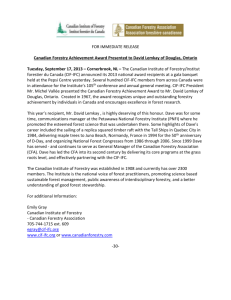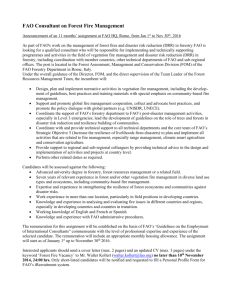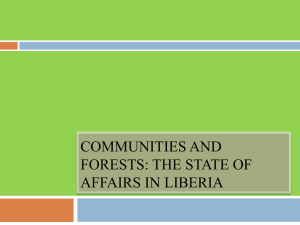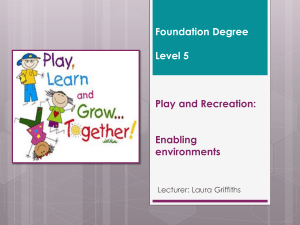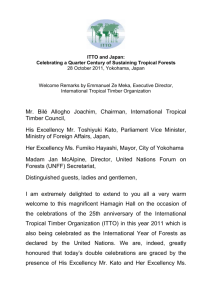Transcript - UBC Blogs
advertisement
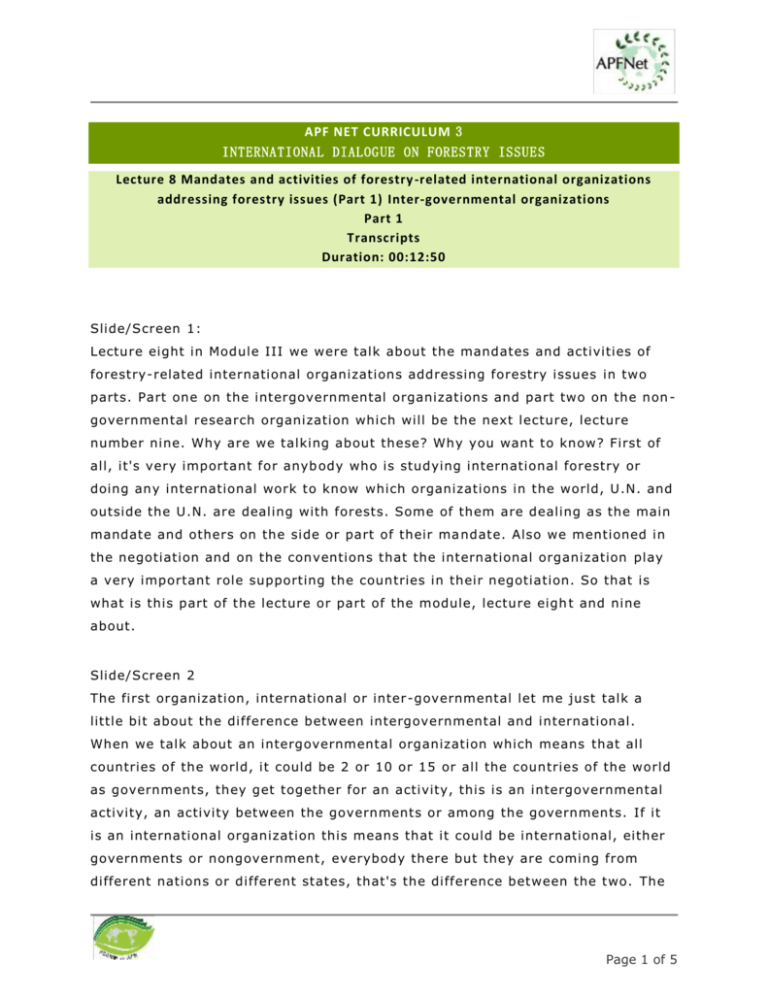
APF NET CURRICULUM 3 INTERNATIONAL DIALOG UE ON FORESTRY ISSUES Lecture 8 Mandates and activities of forestry -related international organizations addressing forestry issues (Part 1) Inter-governmental organizations Part 1 Transcripts Duration: 00:12:50 Slide/Screen 1: Lecture eight in Module III we were talk about the mandates and activities of forestry-related international organizations addressing forestry issues in two parts. Part one on the intergovernmental organizations and part two on the non governmental research organization which will be the next lecture, lecture number nine. Why are we talking about these? Why you want to know? First of all, it's very important for anyb ody who is studying international forestry or doing any international work to know which organizations in the world, U.N. and outside the U.N. are dealing with forests. Some of them are dealing as the main mandate and others on the side or part of their ma ndate. Also we mentioned in the negotiation and on the conventions that the international organization play a very important role supporting the countries in their negotiation. So that is what is this part of the lecture or part of the module, lecture eigh t and nine about. Slide/Screen 2 The first organization, international or inter -governmental let me just talk a little bit about the difference between intergovernmental and international. When we talk about an intergovernmental organization which means that all countries of the world, it could be 2 or 10 or 15 or all the countries of the world as governments, they get together for an activity, this is an intergovernmental activity, an activity between the governments or among the governments. If it is an international organization this means that it could be international, either governments or nongovernment, everybody there but they are coming from different nations or different states, that's the difference between the two. The Page 1 of 5 food and agriculture organization is a United Nations organization, which means that it has membership as our countries as members, like members of the U.N. It's an organization under the U.N. umbrella. Its mission is to eradicate, this is a new mission to eradicate hunger, eradic ate food insecurity and malnutrition. Second mission is to eliminate poverty because poverty is very much related to hunger, food insecurity and malnutrition and other things. And its mission also to sustainably managing natural forest of the world, no, na tural resources. It could be forests, agriculture, water, soil whatever. Slide/Screen 3 Its priority, as an organization, as an intergovernmental organization is to make agriculture, forestry and fisheries more productive and sustainable, that's very important. Not only productive but you have to sustain this productivity, Slide/Screen 4 Its working modalities are two sections, one is to create and disseminate information related to food, agriculture and natural resources. In this case nature sources include forest, fishery and others. So the primary working modality of the organization FAO is to create and disseminate information, collect and disseminate information to member countries, also free. Then another modality is to coordinate knowledge and d ialogue among stakeholders, to facilitate them. It's a neutral seat where it's a neutral organization where all the countries, rich and poor, South and North whoever, they can come together in a neutral setting because its a U.N. organization, it doesn't h ave to take sides, so they just provide the venue and some technical assistance for the countries to carry it. Venue for knowledge sharing, dialogue among all the stakeholders, this could be the governments, the academia, civil society, private sector, cooperatives and so on. So everybody as long as they come for forest, U.N. or FAO member country or credited organization they can come to the meeting or sometimes invited to attend and participate. Slide/Screen 5 First the department is one of the major departments think I feel myself since I was in this department for eight years. It's an very important component of forestry, although we talk about FAO is agriculture and food production, and Page 2 of 5 forestry and fishery come under agriculture, for some technical reasons. But anyway forestry, by i tself, it's a very important department within FAO. Its initiative is to help nations manage the forests in sustainable way, balancing social, economic and environmental objectives so that the present generations can reap the benefits of the earth's forest resources while conserving them to meet the needs of future generations. That's a very nice statement. It's about sustainability in the forest and the sustainability depends on social, economic and environmental objectives. They are pillars for sustainability. You cannot do one without others. Also, part of the mandate of the FAO forestry department is to respond to the rapidly changing environment, reach outside the traditional forest sector, engage in partnerships with all the stakeholders and serve as a global leader in International forest affairs. So again it's more or less the same mission of FAO but related to the forest sector, most of the time FAO is engaged in discussions, collecting information, simulating infor mation from and to member countries and engage all the stakeholders whether the government, NGOs, private sector, youth in the discussion, and try to be a leader in International forest affairs. Slide/Screen 6 Second major player in forestry, although unl ike FAO. FAO is one of the core mandates as our organization's force, it's a department by itself. FAO forestry is there and there are a lot of activities in forestry, mostly related to banking which means l ending, money and so on. But the World Bank, part of its working mechanism is to support the developing countries regarding: financing, policy advice, research and analysis, and technical assistance, that is part of them. Beside, as a bank, its main objective is to lend the money to countries, like any other bank, but this is part of the working mechanism. In the forestry sector or in the band objectives, in general by 2030 in 15 years from now, they hope, the bank hope to end extreme poverty, decrees percent of people living in poverty or less than $1.25 a day to not more than 3%. Currently there is 1.2 billion which is I think it's way way more than 3%. When 1.2 million out to six billion or seven billion that's quite substantial. Also its goal by 2030 the World Bank to promote shared prosperity. You kno w some equality some shared prosperity between the rich and the poor, foster income growth of the bottom 40% of the population of every country. Page 3 of 5 Slide/Screen 7 What is the World Bank's approach to forests? As I say it's a department within the bank. In its latest strategy, the bank adopted a strategy that would be going beyond considering forests as assets to be cleared, logged, and protected. That's very important shift prior to 2000, the bank would not lending any money to any company or any country doing deforestation or logging, even loggin g, no, it was all about conservation, and then find out it doesn't pay at the end. They have to look at conservation but also economic activities. But it is, the forest is more than an asset to be cleared, logged, and protected, it's more than protection. The bank also focuses on forest and their linkage to other activities and sectors. What's the linkage between forest and agriculture? Forest and water? Energy, mining, transportation, these are all sectors related to forest. So the main thrust of the 2002 World Bank Forest Strategy which is the kind of the leading document for the bank's activities in forestry, the main thrust is forests' potential to reduce poverty, that's the idea. It's a bank so poverty is one o f its main objectives so they look at forestry and other sectors, agriculture, fishery whatever. It’s potential to reduce poverty. Slide/Screen 8 A third organization, intergovernmental organization, also very much working in forestry is the International Tropical Timber Organization or ITTO which is located in Yokohama, headquarter is Yokohama, Japan. It's an intergovernmental organization promoting the conservation and sustainable management, use and trade of tropical forest resources. So it's mainly foc using on tropical and you look here, it's very important here to notice that sustainable management, use and trade, because that is international tropical timber organization so the use and trade very are important for forest, tropical forest resources. So the organization ITTO focuses on trade and industry and on sustainable management of forests. This is two sides, most of others are really working on sustainable management whatever, the definition of sustainable management is related to the sector but th ey talk about sustainable management attitude on trade and industry, they pay a lot of attention to these sectors. Page 4 of 5 Slide/Screen 9 The working mechanism in ITTO is quite similar to FAO but with focus on the tropics and focus on trade and use, so ITTO colle cts, analyses and disseminates data on the production and trade of tropical timber, that's very important because it's trade of tropical timber is very important commodity globally, so they collect information, analyze it to make available to countries, an d mostly to the private sector. Also attitude on co-fund projects and action aimed at developing forest-related industries at both community and industrial scales. There is a lot of projects or activities in ITTO supporting the, either the small industry or the big industry so that you know it helped develop the industry, and help inject a lot of sustainability. Slide/Screen 10 [End of Module III, Lecture 8, Part 1] Page 5 of 5


